Yb(NO3)3
Harmless

Posts: 6
Registered: 30-4-2018
Member Is Offline
Mood: No Mood
|
|
Making Potassium metal by distillation with Al and KOH
I recently came across a video of distilling potassium by reducing KOH with Al powder, I was not aware that it was possible to use aluminium powder to
do this, especially since magnesium did not work for codys lab, I, however also got this method to work very well with little difficulty, same as the
video I used a CO2 cartridge with a copper tube for my reaction vessel, added 10g of KOH, dried with a gas torch and put in 3.5g of 200mesh Al powder
(cheap one not flake or dark), my gas torch proved to be not big and hot enough so I put it in a simple blast furnace, this worked quickly and the
potassium distilled over into a test-tube, the potassium seemed pure, no contamination aside from oxidation which is unavoidable without a inert gas,
I got about 2g maybe. It passed all my tests: shiny and metallic when fresh, melts about 60*C, ignites and burns the recognizable potassium purple in
water then explodes.
As I said I was not aware this reaction worked so any ideas are welcome, this seems like a very easy way to make potassium, easier than the catalyzed
magnesium reduction (in my opinion), and also cheaper and more pure than this method but with sodium and KCl
The video came from Огненное ТВ and was called PREPARATION OF POTASSIUM AND SODIUM IN HOME CONDITIONS
link: https://www.youtube.com/watch?v=5JdPQucTjjg&t=6s
The picture is not that great if it came through, the test-tube had potassium coating the inside, and I have not had time to clean it up much.
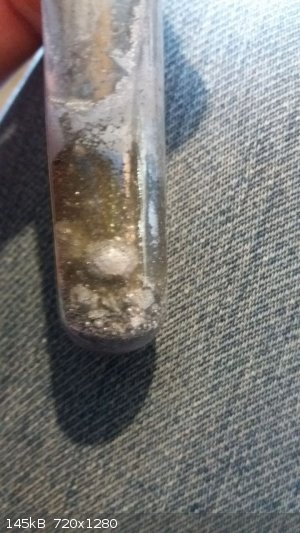
|
|
|
j_sum1
Administrator
       
Posts: 6219
Registered: 4-10-2014
Location: Unmoved
Member Is Offline
Mood: Organised
|
|
Well, I am impressed. This is a good result.
I have seen this video before -- I subscribe to this channel. But I watch few videos since I don't speak Russian.
It sounds like it is worth giving this a crack myself.
Thanks for highlighting this method for us.
|
|
|
AJKOER
Radically Dubious
    
Posts: 3026
Registered: 7-5-2011
Member Is Offline
Mood: No Mood
|
|
Possible reaction path:
3 [ 2 KOH + Heat --> K2O + H2O ]
Al + 3 H2O + Heat --> Al(OH)3 + 3/2 H2
3/2 [ H2 + K2O = 2 K (g) + H2O ]
3/2 [ K2O + H2O --> 2 KOH ]
Implied net reaction for the above:
6 KOH + Al + Heat --> Al(OH)3 + 3 K (g) + 3 KOH
or simply:
3 KOH + Al + Heat --> Al(OH)3 + 3 K (g)
[Edited on 1-5-2018 by AJKOER]
|
|
|
Sigmatropic
Hazard to Others
  
Posts: 307
Registered: 29-1-2017
Member Is Offline
Mood: No Mood
|
|
Good speculation AKJOER, except that Al(OH)3 will dehydrate into aluminium oxide, releasing water. Which will feed back into the reaction, chewing up
more Al under the formation of hydrogen. Also why exactly do you think hydrogen reacts with potassium oxide to form water and elemental potassium. It
is not only strongly endothermic but also uphill with regard to the oxidation potential.
I would speculate this reaction is better described by:
6 KOH + 2 Al --> K2Al2O4 + 2 K2O + 3 H2
Seeing that K2Al2O4 is comparable to the complex K2O*Al2O3 I would argue the equations below are equivalent.
2KOH - - > K2O + H2O
3 H2O + 2 Al --> Al2O3 + 3 H2
To arrive at potassium metal a thermitic reaction between K2O and Al. Probably also ending in K2Al2O4.
4K2O + Al --> 2 K + K2Al2O4
|
|
|
VSEPR_VOID
National Hazard
   
Posts: 719
Registered: 1-9-2017
Member Is Offline
Mood: Fullerenes
|
|
Are there any high temperature desiccants that can be used to absorb any water produced by the thermal decomposition of the aluminium hydroxide?
I am not on a network that permits me to go to ebay and see, but could you use your method to produce cheap potassium metal and sell it? KOH and Al
powder are dirt cheap.
[Edited on 1-5-2018 by VSEPR_VOID]
Within cells interlinked
Within cells interlinked
Within cells interlinked
|
|
|
AJKOER
Radically Dubious
    
Posts: 3026
Registered: 7-5-2011
Member Is Offline
Mood: No Mood
|
|
I did some research, and per a source on the action of H2 on NaOH (which I think may parallel KOH), we have:
H2 + NaOH = NaH + H2O (see Eq 1 on page 2192)
and at 360 C :
NaH + Heat --> Na + 1/2 H2
Source: See 'Revisiting the Hydrogen Storage Behavior of the Na-O-H System' by Jianfeng Mao , et al., in Materials 2015, 8, 2191-2203;
doi:10.3390/ma8052191 . Link to download file: https://www.mdpi.com/1996-1944/8/5/2191/pdf . To quote:
"The DTA profile for NaH shows one endothermic peak at ca. 360 °C, which can be assigned to the decomposition of NaH to Na metal and hydrogen."
--------------------------------------------------
Actually, in my opinion, the actual chemistry is likely a function of the highly anodic metal (like Mg, Zn, Al, Fe, Sn,.., see http://www.zygology.com/cms/upload_area/pdf/Zyg-Anodic-Index... where Zn and Al are the frequent cited sources of so called 'nascent hydrogen'
with HCl) reacting with water as follows:
H2O = H+ + OH-
Al --> Al3+ + 3 e-
e- + H+ = .H = 1/2 H2 (as .H + .H = H2)
Hence, the cited Equation (1) above could actually be the net of the following reactions:
.H + OH- = e- + H2O = e-(aq) (see Eq 37 and Table 2 at https://pdfs.semanticscholar.org/d696/b35956e38351dd2eae6706... )
e- + .H = H- (see http://pubs.rsc.org/-/content/articlelanding/1966/tf/tf96662... )
Net of the two above:
2 .H + OH- = H- + H2O
or, seemingly (but not so at very high temperatures as H2 + Heat = .H + .H):
H2 + OH- = H- + H2O
Further:
H- + Heat --> .H + e- = 1/2 H2 + e- (as .H + .H = H2)
and:
e- + Na+ = Na
My point is if one is going to give credit to the hydrogen, and ignore the role of the highly anodic metal, it is really the mono-atomic hydrogen
radical (.H formed courtesy of the anodic metal or high temperatures), or as historically sometimes referred to, in my estimation, as 'nascent'
hydrogen. Here is a recent account of the surface chemistry of adsorbed .H on aluminum and applications, see https://books.google.com/books?id=1etfSdk55SYC&pg=PA817&... . This last reference per Equation (5) appears to support my reaction presentation
in terms of 2 .H (which is adsorbed on an aluminum surface) and not H2, to quote:
" PbS + 2 .H = Pb + H2S (5) "
[Edited on 3-5-2018 by AJKOER]
[Edited on 3-5-2018 by AJKOER]
|
|
|
Yb(NO3)3
Harmless

Posts: 6
Registered: 30-4-2018
Member Is Offline
Mood: No Mood
|
|
Thanks for the input, to add to it in practice not much water is produced, just slight condensation in the test-tube, so that's not a problem
VSEPR_VOID It is very cheap but laws and regulations in my country make it almost imossible to buy potassium let alone sell it, I had to wait 2 years
for Al powder to be available.
|
|
|
Foeskes
Hazard to Others
  
Posts: 156
Registered: 25-2-2017
Member Is Offline
Mood: No Mood
|
|
Cody used KCl not KOH. I'm pretty sure using KOH with magnesium would work but would be really violent and self sustaining. Like the Mg and NaOH
reaction.
|
|
|
Diachrynic
Hazard to Others
  
Posts: 219
Registered: 23-9-2017
Location: western spiral arm of the galaxy
Member Is Offline
Mood: zenosyne
|
|
This is great! How do you think it got? More than 1000 °C?
we apologize for the inconvenience
|
|
|
Yb(NO3)3
Harmless

Posts: 6
Registered: 30-4-2018
Member Is Offline
Mood: No Mood
|
|
Diachrynic The potassium boils at 759*C so it would not be necessary to get to 1000*, also I used copper tubing to distill out the potassium so I
couldn't let it get that hot, unfortunately when I attempted cesium a while ago the copper tubing did melt, just when I had something I couldn't
afford to fail it did.
Just a photo of the reaction vessel, cost me about $4, no welding or brazing just a friction fit, so pretty much anyone could do it.
|
|
|
Yb(NO3)3
Harmless

Posts: 6
Registered: 30-4-2018
Member Is Offline
Mood: No Mood
|
|
The photos didn't come through so here they are:
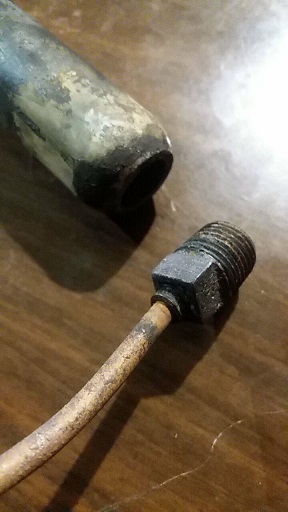 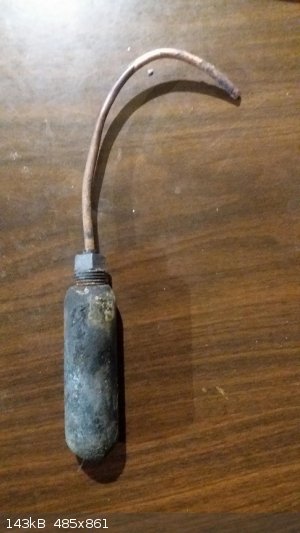
|
|
|
Yb(NO3)3
Harmless

Posts: 6
Registered: 30-4-2018
Member Is Offline
Mood: No Mood
|
|
I just made a basic video on the process so thought I might mention it here, I have got almost exactly the same results twice in a row so it doesn't
seem hard.
video: https://youtu.be/2ORTcQB8kOc
|
|
|
j_sum1
Administrator
       
Posts: 6219
Registered: 4-10-2014
Location: Unmoved
Member Is Offline
Mood: Organised
|
|
Nice! Well done.
This looks like a reliable, efficient setup.
|
|
|
VSEPR_VOID
National Hazard
   
Posts: 719
Registered: 1-9-2017
Member Is Offline
Mood: Fullerenes
|
|
What heat source did you use to get it to 1000C?
Within cells interlinked
Within cells interlinked
Within cells interlinked
|
|
|
Yb(NO3)3
Harmless

Posts: 6
Registered: 30-4-2018
Member Is Offline
Mood: No Mood
|
|
I used wood as fuel for the furnace, it does burn through it very quickly but coal is too hot and can melt the copper tubing, I think charcoal
briquettes would be probably be better.
|
|
|
Foeskes
Hazard to Others
  
Posts: 156
Registered: 25-2-2017
Member Is Offline
Mood: No Mood
|
|
I decided to try it out and it worked! (I used a small butane brazing torch by kovea in a flower pot lined with sand and plaster.$
I got 3 spheres of potassium and when added to water it burns with a nice purple flame.
I used a co2 canister with a high pressure rated brass tube (just pushed in no screws)
For some reason the zinc on the receiving end of the apparatus disappeared leaving only copper.
And sone wired black chunks were in the oil with the K, it reacts with water violently while sinking and seems to produce CuO and is brittle. I assume
it's a mix of potassium and copper oxide or some kind of cuperate from burning potassium.
The main problem I have is before the potassium drops into oil it would stick to the tube and oxidize.
I put some butane in the container so ignore the bubbles.
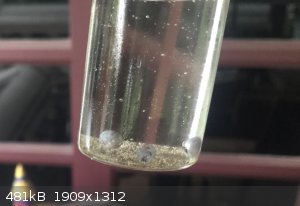
|
|
|
aga
Forum Drunkard
    
Posts: 7030
Registered: 25-3-2014
Member Is Offline
|
|
Sweet !
|
|
|
metalresearcher
National Hazard
   
Posts: 731
Registered: 7-9-2010
Member Is Offline
Mood: Reactive
|
|
I tried, but to no avail
I used a welded steel retort (22mm OD) attached with a gas pipe coupling to a 12mm copper tube ending in a test tube with lamp (mineral) oil.
I first heated the KOH to 600 C to dry it and then let the lye (which is actually molten KOH) freeze and cool down and added the Al powder and
tightened the screws very tightly. Then I heated the retort to 950 C (measured with an infrared contactless pyrometer), but it only bubbled slightly
for less than a minute and after that nothing happened, even no bubbling. A few times I turned off the burner to check for leaks (which then should
appear as white smoke) but no smoke was detected and when the flame was on, no purple/magenta coloring (the K+ ion color) of the flame took place.
But adding water in the opened retort afterwards resulted in a small explosion (so actually a very few K metal was in it), but why did it not
evaporate, despite the retort temperature is well above the bp of K (768 C) ?
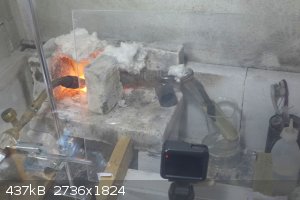
|
|
|
elementcollector1
International Hazard
    
Posts: 2684
Registered: 28-12-2011
Location: The Known Universe
Member Is Offline
Mood: Molten
|
|
Improper mixing, maybe? Though the aluminum would also be molten at that point...
What was your stoichiometry? Maybe you lost most of your K to aluminate and need more starting Al.
Elements Collected:52/87
Latest Acquired: Cl
Next in Line: Nd
|
|
|
metalresearcher
National Hazard
   
Posts: 731
Registered: 7-9-2010
Member Is Offline
Mood: Reactive
|
|
I used stabilized Al powder (3.5g) and 11g KOH of which is I guess 7-8 g real KOH, rest water.
Today I did another try, now with Mg turnings.
I let it run for about 20 minutes, as long as it bubbled in the test tube with the oil.
Here a video of yesterdays attempt with Al powder and after it today's attempt.
https://www.metallab.net/jwplayer/video.php?v=L2NsaXBzL0tPSC...
Afterwards there was some tiny amount of K in the retort, because when watering it, flames appeared (see video).
[Edited on 2019-10-15 by metalresearcher]
|
|
|
draculic acid69
International Hazard
    
Posts: 1371
Registered: 2-8-2018
Member Is Offline
|
|
Koh is about 10%water until it's dried so 11g would be more like 9.9g koh
7-8 is a bit on the low side.
|
|
|